An Underwhelming Experience in North Yorkshire
When my late ex-mother-in-law was alive, she used regularly to visit one of the public gardens run by the Royal Horticultural Society, located on the western edge of Harrogate, North Yorkshire. For some reason I never had the opportunity to visit Harlow Carr... until recently when I visited the UK for a month... but to be perfectly honest I have to ask myself what all the fuss is about. Can half a million visitors a year there know something I don’t? I mean, it’s all very pleasant, but hardly breathtaking, despite the many reports on the internet to the contrary. IMHO it’s just a very over-priced garden which is nevertheless an OK way to spend an hour or so if you have nothing else to do.
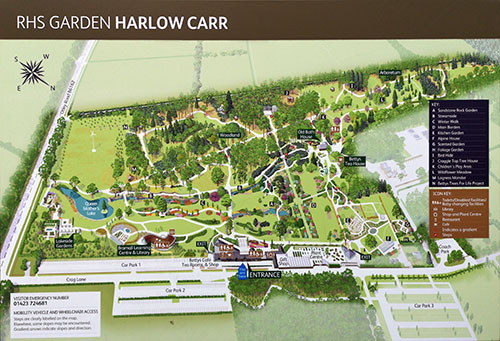
The original Harlow Carr was established by the Northern Horticultural Society which was founded in 1946. The Society leased 26 acres of mixed woodland, pasture and arable land at Harlow Hill from Harrogate Corporation and opened the Harlow Carr Botanical Gardens in 1950. The stated aim at the time was to set up a trial ground where the suitability of plants for growing in northern climates could be assessed.
The Royal Horticultural Society merged with the Northern Horticultural Society in 2001 and, with the merger, came the acquisition of Harlow Carr. Since then the original 26 acres has since been extended to 58 acres.
Originally this area was part of the Forest of Knaresborough, which was an ancient royal hunting ground. Springs of sulphur water were discovered here in 1734 but it wasn’t until 100 years later that the then-owner of the estate, Henry Wright, built a hotel (the Harrogate Arms ) and a bath house. People paid half a crown (about £11.00 at today’s prices) to bathe in the warm waters, and the gardens were laid out around the bath house.
I visited in April when the tulips were in full bloom, and I have to admit that they set off a nice backdrop near the main entrance.
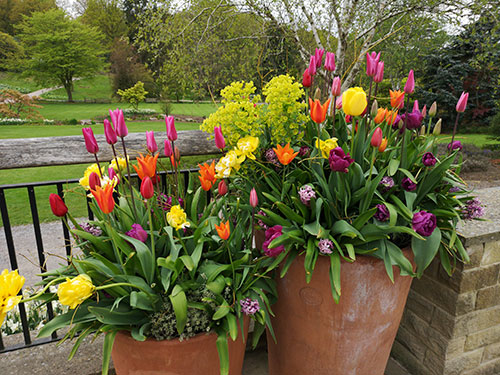
Ericas (heathers) too were just coming out in bloom, yet they were a week or two away from being in any way stunning.
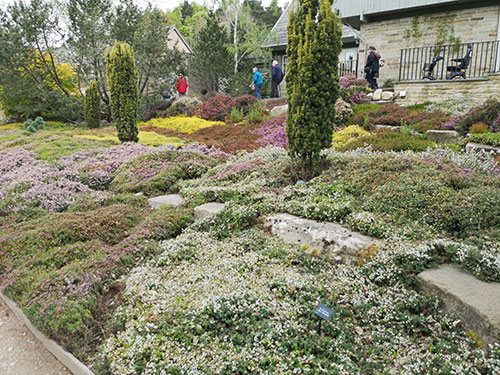
Turning to the right there’s a nice idea which has been dubbed the ‘Rhubarb Crumble and Custard’ garden – which was awarded a silver medal at the Chelsea Flower Show in 2010. In the bowl is Stockbridge Arrow, an early outdoor grown rhubarb, while bronze fennel creates the feathery sugary topping. The ‘custard' is yellow sedum.
Featured in the garden is also liquorice (synonymous with locally made Pontefract Cakes) and hops, representing Yorkshire's brewing heritage. The traditional dry stone wall behind is meant to represent the topping, while a handcrafted chair resembles a spoon. OK, it takes some imagination (and a large explanatory notice board) to work all that out, but the idea is quite quaint.
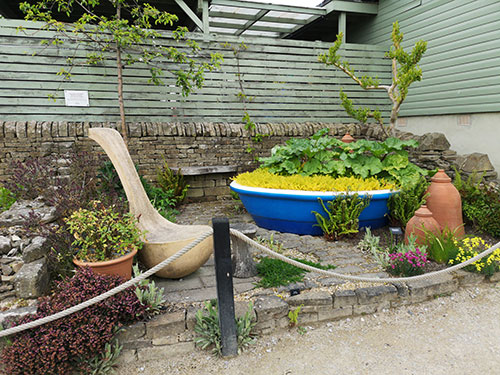
A lone windmill representing sycamore seed heads turns in the wind, but again the idea is probably better that what is achieved in practice.
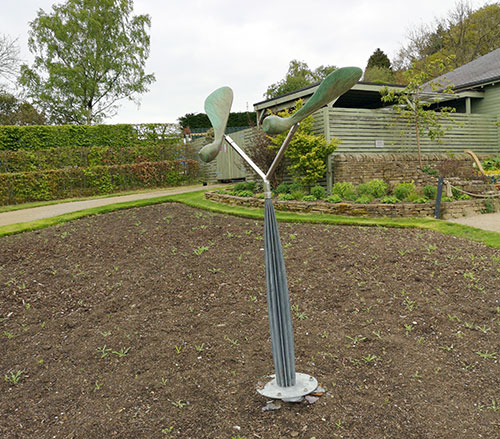
A wall of apple tree plants is covered in blossom which makes a nice addition to the path...
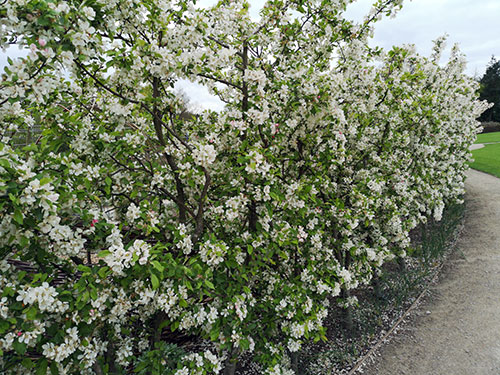
...behind which is an alpine zone greenhouse ... not to keep them warm, but to keep them dry, since many alpines cannot survive a cold wet winter.
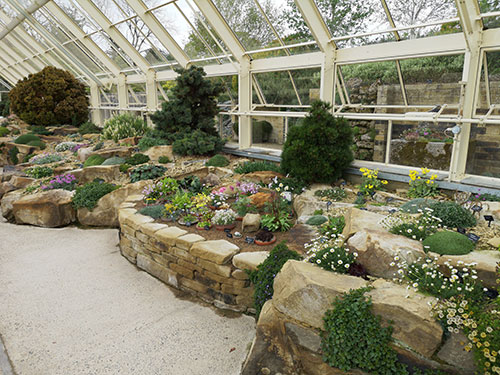
I can’t get very excited by alpine plants, however, as their appeal seems to be getting something to survive in non-native conditions, rather than something that is all that intrinsically beautiful.
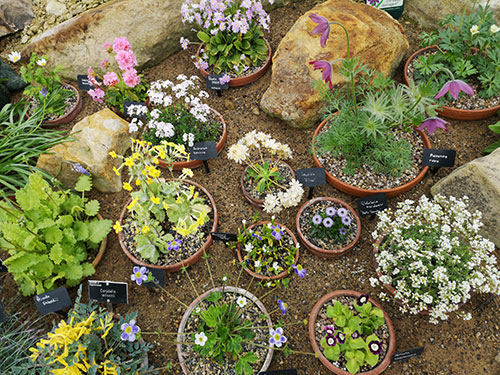
Throughout the year Harlow Carr runs a number of workshops and courses. Today there is a free demonstration of cooking that is a good place to park your tired bottom. Local personalities Martin and Jill Fish are busily trying to promote their book and demonstrate how to cook ‘perfect’ potatoes and rhubarb crumble.

Unfortunately, the barbecue oven behind their demo bench has been invaded by squatters in the form of blackbirds having built a nest, so the oven cannot be used. Instead we listen to Martin Fish describing how to grow potatoes in succession in order to enjoy new potatoes over a long planting season. His wife fries them up on an electric ring, while we all smell the wafting aromas with growing appetites.
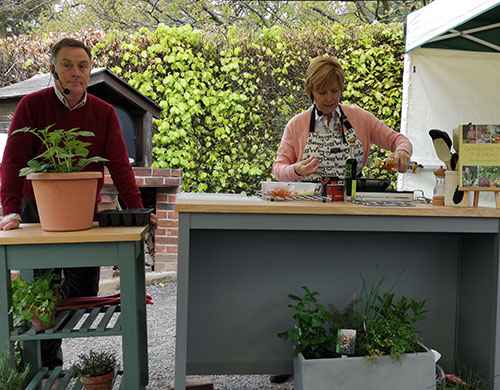
To make it more appealing, she adds chopped chilli to the mix... but is so busy making well rehearsed jokes with her husband that she inadvertently adds twice the amount of chilli, with the result that when it comes to trying out our samples, one member of the audience is nearly at the stage of having to be carried off by his partner, breathing fire.
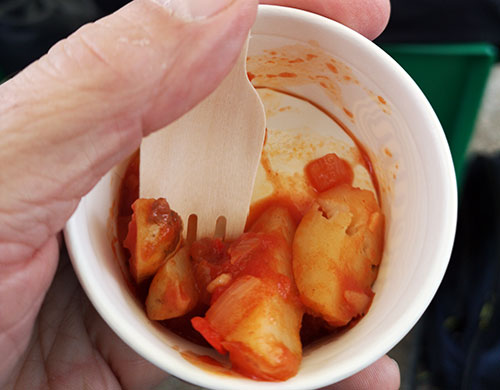
The rhubarb is similarly underwhelming and I don’t see anyone rushing forward to buy their book.
After that we head off to the arboretum. Again, it is pleasant enough, but there is no ‘wow’ factor, at least as far as I am concerned.
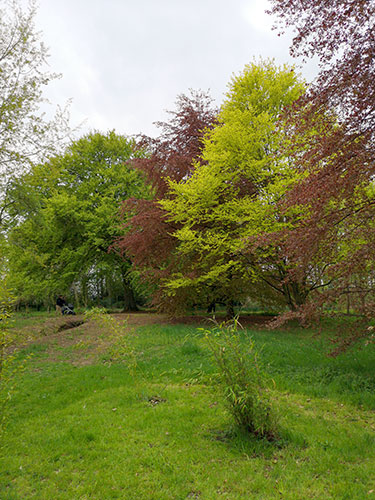
But something that catches my eye is ignored by virtually every other visitor in this part of the park. It’s a clump of purple (or black) bamboo that I have only ever seen before in Beijing’s Purple Bamboo park... a rare species whose stems are dark compared with other types of bamboo.
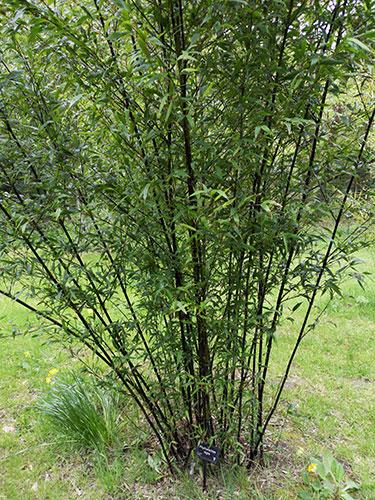
Walking round, looking for something else to make one stop and take notice, I eventually come across this unmarked ‘sculpture’ of, what... a wood urchin? Rather sweet, I guess, in a funny kind of way.
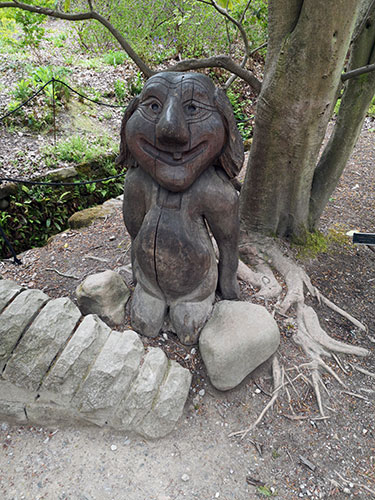
There’s a section of garden devoted to rhododendrons and azaleas, but having visited the Himalayan Gardens only the previous day that features hundreds of these plants, I find this display somewhat lacking in wow-factor.
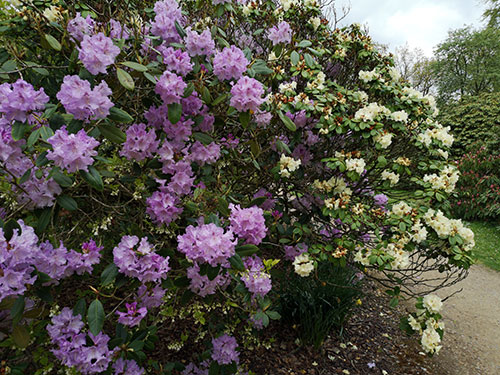
Likewise there are some pretty magnolias, but again, nothing to make one determined to come back again and again.
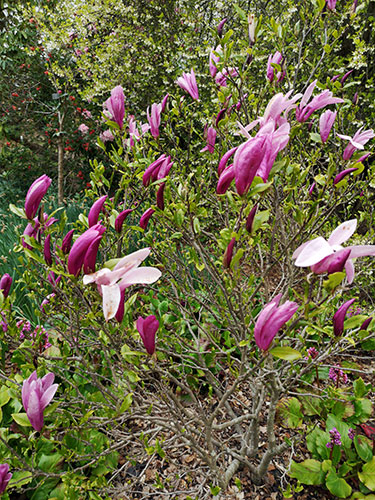
After this, the park goes rapidly downhill in my estimation. Someone has been so desperate to attract the kids that they have decided to create temporary sculptures such as this drone bee which has been given the name of Betsy. Clever? Maybe. But appealing? I’m not convinced.
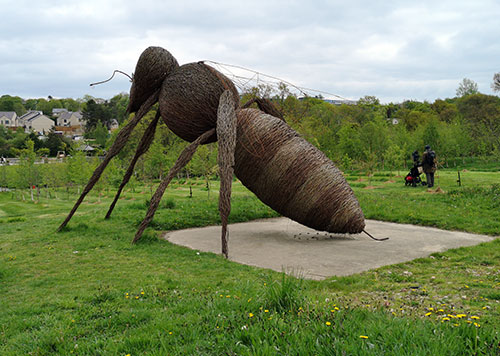
There is also a ‘Logness Monster’... Oh please!
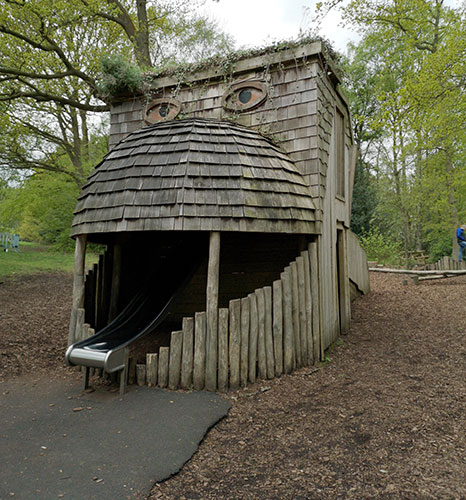
And dinosaurs littering the verdant banks. (Why does everyone assume that kids just have to see dinosaurs wherever they go?)
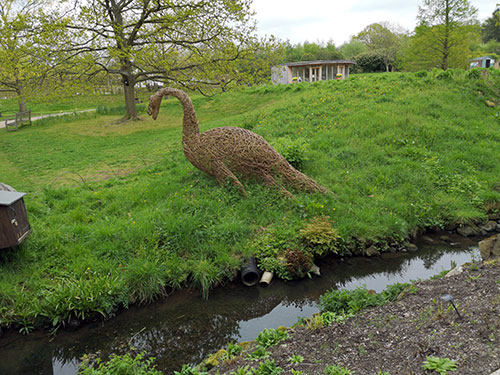
More interesting is a whole array of skunk lilies – originally from America, these plants are now banned in the UK and many parts of the world since they smother and take over virtually all habitats. One is simply not allowed to plant them or take cuttings from them, and only existing plants can be kept as long as they are stopped from spreading.
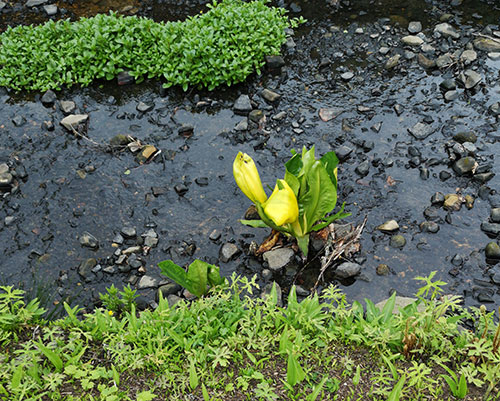
At last we come across a tulip competition where amateur growers show off their best specimens.
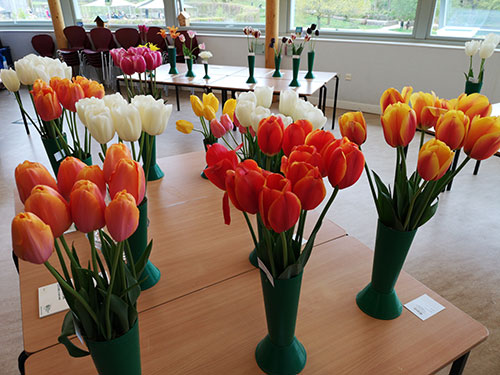
Some are stunning – I love this ‘parrot’ variety.
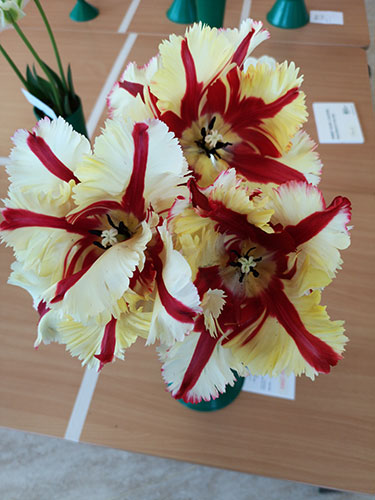
While the black tulips make a sombre display.
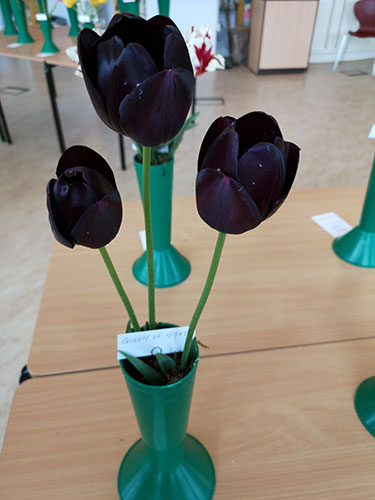
But tulip fatigue soon sets in when you peer at yet another vase of cultivars.
Outside there are one or two miniature show gardens that have been created to show off in special venues, such as the Chelsea Flower Show I referred to above.
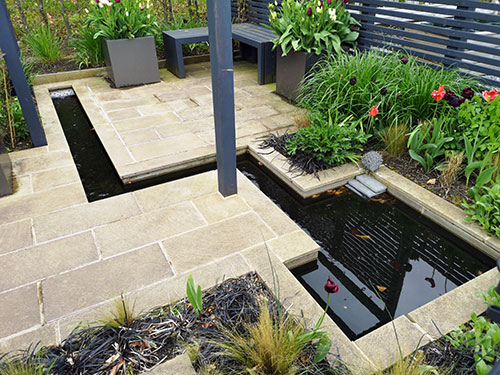
But frankly that’s it. So, a pleasant enough hour or two of wandering, but with an exorbitant entrance fee I really do have to wonder why anyone would make a point of coming back here again and again. Maybe they simply don’t know that there are very much better gardens to visit that charge only a fraction of the price of this one.
Harlow Carr Garden can be found on Crag Lane, off Otley Road (B6162) about a mile and a half from the centre of Harrogate.
